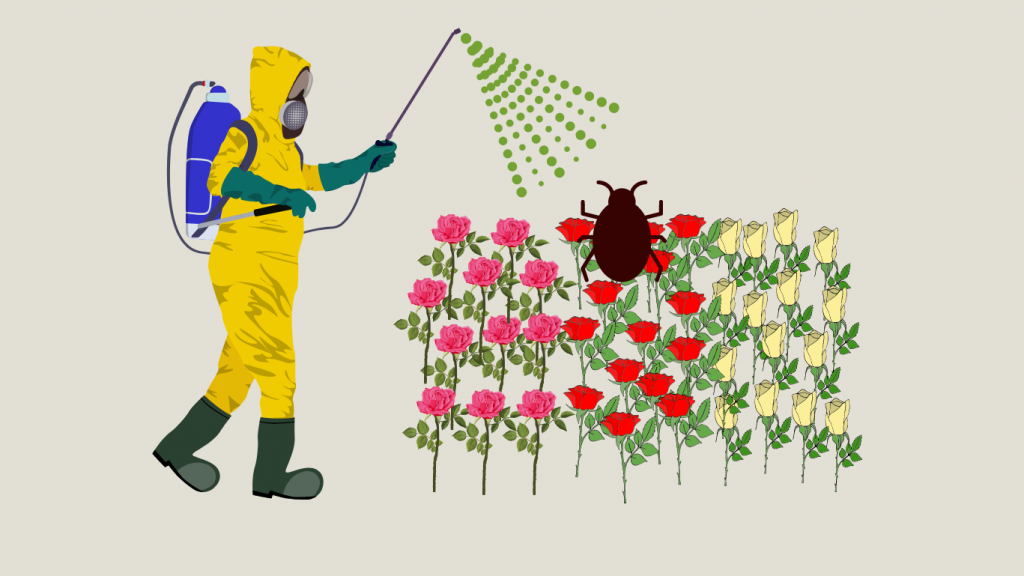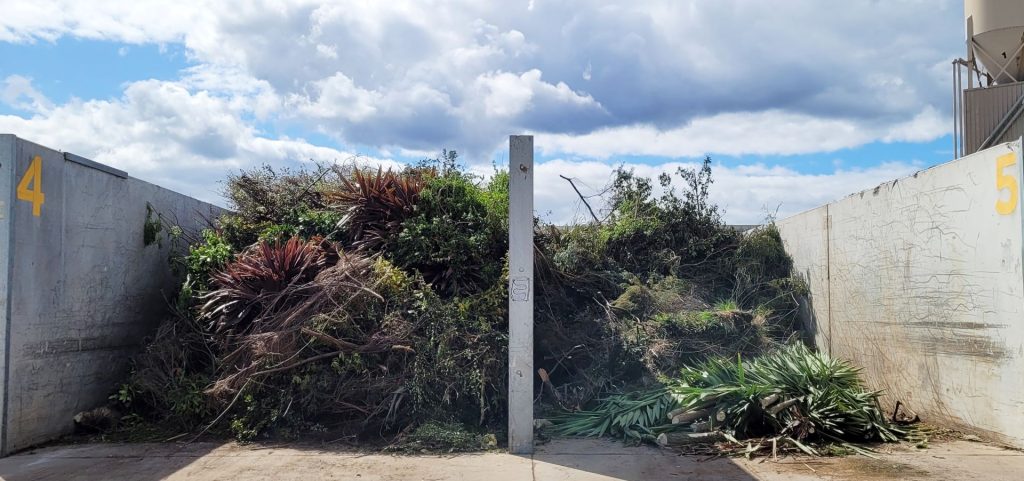Pesticides and flowers
Pesticides are substances used to control pests that threaten agriculture. Because they are inherently toxic, they can cause a range of environmental problems, including threats to human and animal health.

What are pests?
In agriculture, a pest is anything that damages a crop. Some pests eat plants (animals, rodents, insects), some cause disease (fungi, bacteria, viruses, protozoans), and some compete with plants for nutrients (weeds).
What are pesticides?
Pesticides are substances used to kill, repel or control pests that threaten agriculture.
There are over 1000 different chemical pesticides in use around the world. For example, rodenticide is used against rodents, insecticide against insects, fungicide for fungal pests and herbicide for weeds.
The problem with pesticides
On one hand, pesticides can benefit agriculture as they help to maximise crop yield by keeping the crop free of pests. This can be particularly helpful in countries experiencing food shortages or those with arable land in short supply.
On the other hand, pesticides are by their nature toxic and can harm the health of other plants, animals (including humans) and microorganisms. Some pesticides are much more toxic than others, and the rules around pesticide use vary from country to country.
For example, neonicotinoids are a type of insecticide that kill insects like aphids. But neonicotinoids harm more than just the target species – the chemical is at least partly responsible for the global decline in honeybee species.
Some pesticides remain in the environment for a long time and accumulate in the food chain. One group of chemicals, known as persistent organic pollutants (POPs), is of particular concern. POPs are synthetic, hazardous chemicals that threaten human health, biodiversity and the health of the planet’s ecosystems.
How are humans and animals affected by pesticides?
The health effects from pesticide exposure can be acute or chronic, depending on how long and how much a person or animal has been in contact with the chemicals. Pesticides can be inhaled, ingested or they can enter the body through skin contact. Eating food containing pesticides can result in the chemicals entering the body via the gut.
Who is most at risk?
People at greatest risk of unsafe pesticide exposure are those working with pesticides, including agricultural workers who apply them, and other people in the immediate area during and right after they are spread. Adverse effects can occur when someone has been exposed to an unsafe amount of a pesticide or if a toxic pesticide is used.
Pesticide exposure can result in acute poisoning or long-term health impacts. Many different health problems have been reported from workers all over the world who have been associated with daily pesticide exposure. According to the UNEP, about 385 million cases of non-fatal unintentional pesticide poisonings have been estimated to occur every year, with approximately 11,000 deaths.
Why aren’t toxic pesticides banned?
Some older pesticides have been banned because of the health effects they have on the environment and other animal species. But these bans are not universal, some countries continue to use pesticides that are banned in other countries, and some farmers continue to use banned pesticides.
International conventions provide a means for countries to protect their populations from exposure to toxic pesticides. However, the success of these conventions requires information about the incidence and circumstances of pesticide exposures, as well as the health impacts of these exposures — and often this is lacking.
Better pesticide use and alternatives to pesticides
There are several ways agriculture can reduce its use of pesticides.
Scientists are finding innovative ways to ensure pesticides “stick” to plants. Pesticides are not particularly efficient – when sprayed on crops, up to 98% can run off the plant and into the surrounding environment. Using less but more targeted pesticides would reduce this pollution.
Integrated pest management (IPM) is a more environmentally friendly approach to pest management that encompasses a range of management strategies. On of these is biological control, which can predatory insects to attack the pests, or other living organisms like bacteria and fungi, that cause disease in the pests. In IPM, using chemical pesticides is always the last resort.
Organic farms limit their use of pesticides to natural compounds only, and regenerative farms often don’t use pesticides at all, but rely on maintaining the health of soil, growing robust plants that can withstand attacks, and attracting beneficial insects that feast on pests.
The problems with the flower industry and pesticides
Aside from the lack of data and regulation, the main issue associated with pesticide use is incorrect use.
Incorrect use might mean using the wrong dose, the wrong chemicals, unsafe application conditions (lack of PPE) or using the chemicals at the wrong time in a crop’s growing cycle.
Flowers are not subject to the same pesticide regulations as food products. When imported flowers pass through customs, they are regularly checked for pests or disease that might cause problems if introduced into the importing country. However, no systems exist to check for banned chemicals or unsafe levels of pesticide residue. The lack of limits on pesticides in flower-products can influence pesticide overuse in production areas.
One review on pesticide use in floriculture showed that of 201 substances identified in cut flower cultivation, 93 were banned in the EU. This problem can be a consequence of international trade, as many flowers come from areas where pesticide use is not well regulated.
These different national regulations can also be a problem for workers involved with growing flowers. Pesticide use in floriculture has been linked to respiratory issues and skin conditions, reproductive disorders, birth issues and adverse health effects in residents of flower production areas such as poorer neurobehavioral development.
What about florists?
Florists can be exposed to pesticides in the workplace through handling flowers with pesticide residues. One study of Belgian florists showed that many pesticides can be readily absorbed through the skin of florists during preparing bouquets and handling. A total of 70 residues were detected in the urine of the florists in the study, demonstrating that florists are exposed daily to pesticides that could potentially affect their health.
Another study detected a total of 111 active substances (mainly insecticides and fungicides) on the gloves of florists handling pesticide covered flowers, with one pesticide being nearly four times the acceptable limit for exposure.
How can pesticide exposure be prevented?
Agricultural workers
- Use non-chemical pest control wherever possible to minimise use.
- Use and apply chemicals correctly by following manufacturer instructions.
- Always wear suitable PPE when handling and applying pesticide chemicals.
- Always dispose of chemicals and containers in accordance with local regulations.
Florists
- Always wear gloves when handling flowers treated with pesticides, particularly those with unknown provenance or those grown in developing countries where pesticide can be subject to poor regulation. Latex gloves are unsuitable as some pesticides can pass through the latex. The best gloves are rubber with silver lining. Cotton are suitable too (if washed each day), although less practical when they become wet.
- Always wash hands and arms after handling flowers and before eating and drinking.
- Never consume commercially grown edible flowers, unless they are guaranteed to be pesticide and chemical free and safe to eat.
- Support farmers who support low-chemical pesticide control measures such as IPM (integrated pest management), biological control strategies and organic farming methods.
- When buying imported flowers, look for certified flowers that address pesticide use as part of the certification scheme
What happens to pesticides in compost?
Most pesticides will break down fairly quickly in a biologically active composting system and the rate of pesticide decomposition increases with decreasing concentration.
Some environmentally persistent pesticides such as the POPs may take much longer degrade. These substances can present an environmental risk if concentrations are high enough, but the lower the concentration of pesticide in a compost, the lower the risk of problems. This issue can be addressed by increasing the concentration of other, untreated material such as garden trimmings and other plant cuttings in the mix.
Composting of commercially grown flowers in municipal or industrial composting facilities is encouraged for all cut flowers and plant waste material, regardless of the flowers’ provenance.

Further reading: